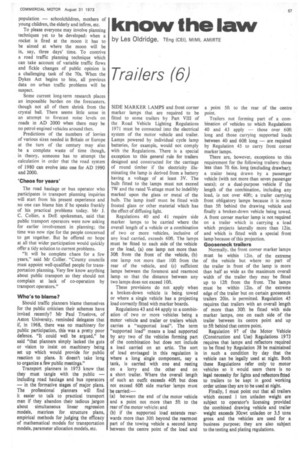know the law
Page 53

If you've noticed an error in this article please click here to report it so we can fix it.
by Les Oldridge, TEng (CEI), MIMI, AMIRTE
Trailers (6)
SIDE MARKER LAMPS and front corner marker lamps that are required to be fitted to some trailers by Part VIII of the Road Vehicle Lighting Regulations 1971 must be connected into the electrical system of the motor vehicle and trailer. Lamps powered by individual cycle lamp batteries, for example, would not comply with the Regulations. There is a special exception to this general rule for trailers designed and constructed for the carriage of round timber if the electricity illuminating the lamp is derived from a battery having a voltage of at least 3V. The bulb fitted to the lamps must not exceed 7W and the rated Vv attage must be indelibly marked upon the glass or metal of the bulb. The lamp itself must be fitted with frosted glass or other material which has the effect of diffusing light.
Regulations 40 and 41 require side marker lamps to be carried where the overall length of a vehicle or a combination of two or more vehicles, inclusive of any load carried, exceeds 60ft. The lamps must be fitted to each side of the vehicle or the load, (a) one lamp not more than 30ft from the front of the vehicle, (b) one lamp not more than 10ft from the rear of the vehicle, and (c) sufficient lamps between the foremost and rearmost lamp so that the distance between any two lamps does not exceed 10ft.
These provisions do not apply when a broken-down vehicle is being towed or where a single vehicle has a projecting load correctly fitted with marker boards.
Regulations 43 and 44 apply to a combination of two or more vehicles being a motor vehicle and trailer or trailers which carries a "supported load". The term "supported load" means a load supported by any two of the vehicles forming part of the combination but does not include a load carried on an artic. The sort of load envisaged in this regulation is where a long single component, say a tank, is carried with one end resting on a lorry and the other end on a short trailer. Where the overall length of such an outfit exceeds 40ft but does not exceed 60ft side marker lamps must be carried:— (a) between the end of the motor vehicle and a point not more than 5ft to the rear of the motor vehicle; and (b) if the supported load extends rearwards more than 30ft beyond the rearmost part of the towing vehicle a second lamp between the centre point of the load and a point 511 to the rear of the centre point.
Trailers not forming part of a combination of vehicles to which Regulations 40 and 43 apply — those over 60ft long and those carrying supported loads between 40 and 60ft long — are required by Regulation 45 to carry front corner marker lamps.
There are, however, exceptions to this requirement for the following trailers: those less than 7ft 6in. long (excluding drawbar); a trailer being drawn by a passenger vehicle (with not more than seven passenger seats); or a dual-purpose vehicle if the length of the combination, including any load, is not over 40ft; a trailer carrying front obligatory lamps because it is more than 5ft behind the drawing vehicle and finally a broken-down vehicle being towed. A front corner marker lamp is not required on a trailer which is carrying a load which projects laterally more than 12in. and which is fitted with a special front lamp because of this projection.
Gooseneck trailers
Normally, the front corner marker lamps must be within 12in. of the extreme of the vehicle but where no part of the trailer in front of the lamp is more than half as wide as the maximum overall width of the trailer they may be fitted up to 1211 from the front. The lamps must be •within 12in. of the extreme edge of the trailer but on certain gooseneck trailers 20in. is permitted. Regulation 45 requires that trailers with an overall length of more than 3011 be fitted with side marker lamps, one on each side of the trailer between its centre point and up to 5ft behind that centre point.
Regulation 97 of the Motor Vehicle (Construction and Use) Regulations 1973 requires that lamps and reflectors required to be fitted by Regulation 38 be maintained in such a condition by day that the vehicle can be legally used at night, Both these Regulations refer only to motor vehicles so it would seem there is no legal necessity for lights and reflectors fitted to trailers to be kept in good working order unless they are to be used at night.
Finally, I must point out that all trailers which exceed 1 ton unladen weight are subject to operator's licensing provided the combined drawing vehicle and trailer weight exceeds 30cwt unladen or 3.5 tons gross and the vehicles are used for a business purpose; they are also subject to the testing and plating regulations.












































































































